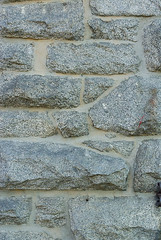 Section of a Kensington tonalite wall from a building at the National Zoo, D.C.
Section of a Kensington tonalite wall from a building at the National Zoo, D.C.
Photographer: Tony FlemingUntil the early 1900s, Kensington Tonalite was quarried in close to a dozen places in and near the park, and was known in the building stones trade as “Rock Creek Granite” because of its distinctive salt-and-pepper appearance. Desirable as a fine building stone at the turn of the last century, this attractive stone graces innumerable structures built in that era throughout the northwest part of the District. It also makes up some of the stream-rounded stones used in Boulder Bridge at the park. Kensington Tonalite is well-displayed in the adjacent Cleveland Park and Mount Pleasant neighborhoods, and in the National Zoo, where it can be seen facing many walls, foundations, and entire buildings. Accessible examples of old stone quarries in the park can be found in Broad Branch, Melvin Hazen Valley, and along Rock Creek just upstream of Montrose Park. These abandoned quarries are intriguing places to visit today, and reveal fascinating stories of both the geologic and human history of the area.
Tip: On the Rock Creek Park Map Viewer, search for "quarry" to see the location of historic quarries.


